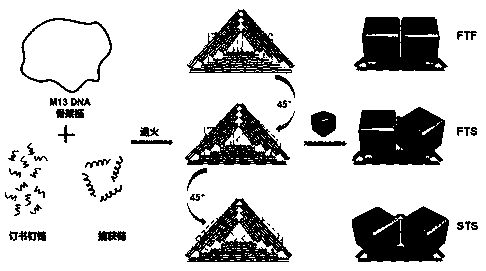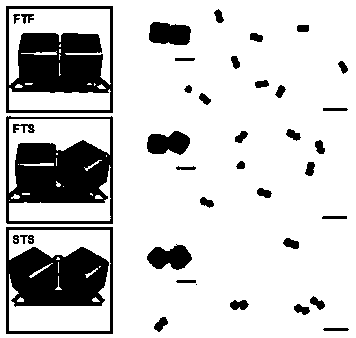Method for forming dimer structure by assembling DNA origami template and nanometer gold cube based on surface enhanced Raman effect
A surface-enhanced Raman and nano-gold technology, which is applied in the field of DNA nanometers, can solve the problems of assembly neglect and achieve the effects of rich diversity, precise space addressability, and efficient and precise assembly
- Summary
- Abstract
- Description
- Claims
- Application Information
AI Technical Summary
Problems solved by technology
Method used
Image
Examples
Embodiment 1
[0031] Example 1: Preparation of triangular DNA origami with specific sites
[0032] Such as figure 1 Shown: Using phage M13mp18 single-stranded DNA as the backbone strand, it anneals with more than two hundred short scaffold strands and dozens of capture strands to form a triangular DNA origami. Its specific operation is:
[0033] (1) Mix M13mp18 bacteriophage circular single-stranded DNA, unmodified staple strand, and terminal-modified capture strand (CaptureDNA) at a molar ratio of 1:10:10, that is, the added volumes are 2.5 μL and 5 μL, respectively. μL, 5 μL, then 10 μL 10×TAE-Mg 2+ Buffer (Mg 2+ concentration 12.5 mol / L), add ultrapure water to a final volume of 100 μL, shake well.
[0034] (2) Place the mixed solution in step (1) in a PCR instrument and anneal at a rate of 0.1°C / 10 s from 95°C to 20°C. After the reaction, use a 100 kDa ultrafiltration tube to centrifuge to remove excess staple chains. 4 ℃ for later use.
[0035] Among them, the sequence of the cap...
Embodiment 2
[0039] Embodiment 2: Preparation of nano gold cubes modified by thiol DNA
[0040] In a certain buffer environment, thiol DNA single strands were added to modify the surface of the nano-gold cube, and the assembly was completed by adding salt (NaCl) aging to obtain a nano-gold cube covered with thiol DNA. Its specific operation is:
[0041] (1) Take 200 μL of 10 nm gold particles in a 1.5 mL centrifuge tube, centrifuge at 12000 rpm for 15 min, remove 120 μL of supernatant, add 10 μL of thiol DNA and 10 μL of 5×TBE (89 mM Tris, 89 mM boric acid, 2 mMEDTA, pH 8.0) buffer solution, vortexed to mix.
[0042] (2) Place the sample in step (1) in a mixer, and incubate at 37°C and 300 rpm for 4-6 hours.
[0043] (3) Add 10 μL of 3M NaCl solution to the sample incubated in step (2). Pay attention to adding 4 times, each adding 2.5 μL of 3 M NaCl solution at intervals of 30 minutes. Incubate overnight at 37°C. The purpose of adding salt (NaCl) step by step is to enable the assembly o...
Embodiment 3
[0045] Example 3: Preparation of three dimer configurations
[0046] Such as figure 1 As shown, the thiol DNA-modified nano gold cube prepared in Example 2 was mixed with the triangular DNA origami prepared in Example 1, annealed and assembled. Its specific operation is:
[0047] The DNA origami and nano-gold cubes modified with sulfhydryl DNA were uniformly mixed in 1×TAE-Mg at a molar ratio of 1:2. 2+ In the buffer, the sample was placed in a PCR machine and annealed for 11 h. The annealing program was to cool from 45 °C to 20 °C at a rate of -0.1 °C / 10 s, and cycled for 4 cycles to completely hybridize the DNA origami and the nano-gold cube. The capture chains at different positions were designed on the surface, and finally assembled to form three kinds of nano-gold cubic dimers: face-face (FTF), face-edge (FTS) and edge-edge (STS).
PUM
 Login to View More
Login to View More Abstract
Description
Claims
Application Information
 Login to View More
Login to View More - R&D
- Intellectual Property
- Life Sciences
- Materials
- Tech Scout
- Unparalleled Data Quality
- Higher Quality Content
- 60% Fewer Hallucinations
Browse by: Latest US Patents, China's latest patents, Technical Efficacy Thesaurus, Application Domain, Technology Topic, Popular Technical Reports.
© 2025 PatSnap. All rights reserved.Legal|Privacy policy|Modern Slavery Act Transparency Statement|Sitemap|About US| Contact US: help@patsnap.com



